英语语法讲解不定式
- 格式:doc
- 大小:94.00 KB
- 文档页数:13
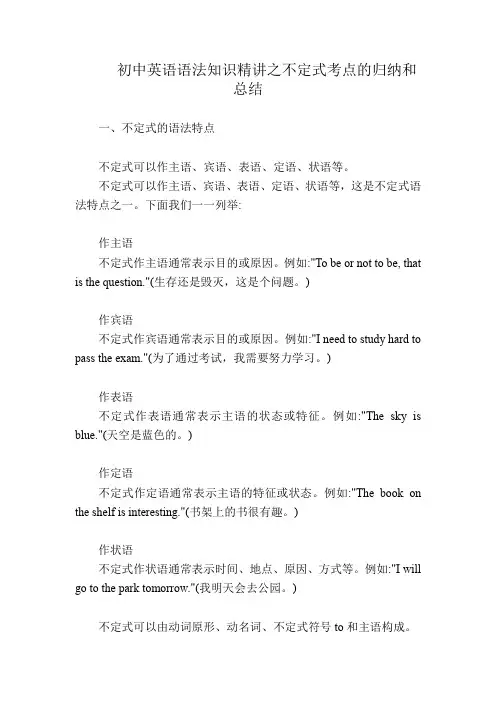
初中英语语法知识精讲之不定式考点的归纳和总结一、不定式的语法特点不定式可以作主语、宾语、表语、定语、状语等。
不定式可以作主语、宾语、表语、定语、状语等,这是不定式语法特点之一。
下面我们一一列举:作主语不定式作主语通常表示目的或原因。
例如:"To be or not to be, that is the question."(生存还是毁灭,这是个问题。
)作宾语不定式作宾语通常表示目的或原因。
例如:"I need to study hard to pass the exam."(为了通过考试,我需要努力学习。
)作表语不定式作表语通常表示主语的状态或特征。
例如:"The sky is blue."(天空是蓝色的。
)作定语不定式作定语通常表示主语的特征或状态。
例如:"The book on the shelf is interesting."(书架上的书很有趣。
)作状语不定式作状语通常表示时间、地点、原因、方式等。
例如:"I will go to the park tomorrow."(我明天会去公园。
)不定式可以由动词原形、动名词、不定式符号to和主语构成。
不定式可以由动词原形、动名词、不定式符号to和主语构成,这是不定式语法特点之一。
下面我们一一列举:动词原形不定式可以由动词原形构成,例如:"I want to eat pizza."(我想吃披萨。
)动名词不定式也可以由动名词构成,例如:"She enjoys playing soccer."(她喜欢踢足球。
)不定式符号to不定式还可以由不定式符号to和主语构成,例如:"To be or not to be, that is the question."(生存还是毁灭,这是个问题。
)主语不定式还可以由主语构成,例如:"The teacher gave the students a task to complete."(老师给学生布置了一个任务完成。
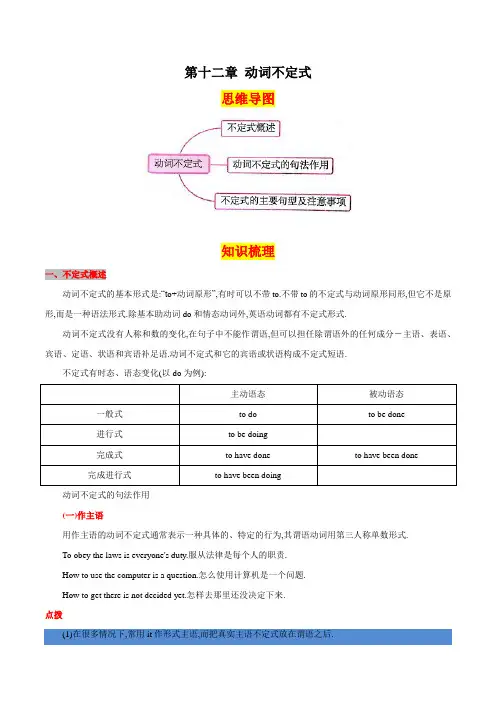
第十二章动词不定式思维导图知识梳理一、不定式概述动词不定式的基本形式是:“t o+动词原形”,有时可以不带to.不带to的不定式与动词原形同形,但它不是原形,而是一种语法形式.除基本助动词do和情态动词外,英语动词都有不定式形式.动词不定式没有人称和数的变化,在句子中不能作谓语,但可以担任除谓语外的任何成分-主语、表语、宾语、定语、状语和宾语补足语.动词不定式和它的宾语或状语构成不定式短语.不定式有时态、语态变化(以do为例):动词不定式的句法作用(一)作主语用作主语的动词不定式通常表示一种具体的、特定的行为,其谓语动词用第三人称单数形式.To obey the laws is everyone's duty.服从法律是每个人的职责.How to use the computer is a question.怎么使用计算机是一个问题.How to get there is not decided yet.怎样去那里还没决定下来.点拨(1)在很多情况下,常用it作形式主语,而把真实主语不定式放在谓语之后.It was difficult to sell my car.我的车很难卖掉.It's not known where to stay for the night.在哪里过夜还不知道.(2)如果要表示不定式的动作是谁做的,一般在不定式前加一个for短语.It will be a regret for us not to help him.我们没有帮助他是个遗憾.(3)在某些形容词(如kind, good, nice, wise, unwise, clever, silly, wrong, right, foolish, stupid, careless, considerate, rude, naughty, impolite等)作表语时,不定式前常可加一个以of引起的短语,来说明不定式指的是谁的情况.It would be rude of us to refuse their invitation.(我们)拒绝他们的邀请,会显得无礼.(二)作表语作表语,一般紧跟在系动词,如:be, seem, get等后面,用以说明主语.The question is when to start.问题是什么时候启程.You seem to have lost weight.你好像减肥了.What we have to do first is to find a solution.我们得做的第一件事是找出一个解决办法.点拨当不定式所作的表语仅用来说明主语的内容时,这个不定式只作单纯的表语,而不具有未来的含义.(三)作宾语能以不定式作宾语的动词很多,常见的有:agree, begin, decide, expect, forget, hope, learn, like, manage, pretend, start, try, want, wish等.Do you wish to see the manager?你想见经理吗?They decided to learn English hard.他们决定好好学英语.Don't forget to meet me at 6:00.别忘了六点钟和我见面.有些动词,如:tell, advise, show, teach, know, forget, learn , remember, show,understand, see, wonder, hear, find out, explain, decide, discuss等后面,常用带疑问词的不定式作宾语.We don't know who(whom)to ask.我们不知道问谁.We asked how to get to the station.我们问怎么到达车站.Have you decided where to go for your holidays?你们决定到哪儿度假了吗?I don't know whether to apply for the job or not?那份工作我不知道申请还是不申请?(四)作定语I have no time to waste.我没有时间可浪费.Let me find a place to park.我来找个停车的地方.He is always the first to come to work and the last to leave.他总是第一个来上班,最后一个走.点拨不定式修饰something, anything, nothing时,放在它们的后面.如果something, anything, nothing 有形容词来修饰,词序是something(nothing...)+形容词+不定式.My father had something to do.我父亲有事要办.Have you got anything important to buy?你有什么重要的东西要买吗?(五)作状语不定式常可用作状语,修饰动词,表示行为的目的、结果、原因等.一般放在被修饰词之后,但在表示目的时,为了强调也可放在句首.1.作目的状语为加强语气在否定式前还可加上in order或so as组成词组(即:in order to...,so as to...),作状语表示目的.To live a long and healthy life, we must learn to have a balanced diet.为了能过长寿而健康的生活,我们必须懂得吃均衡的食品.I stayed there so as to see what would happen.我留在那儿,为的是想看看会发生什么事.In order to help him, we would do everything we can.为了帮助他,我们愿意尽一切力量.2.作结果状语表结果,其逻辑主语通常亦是全句的主语.在“so...as to...”“such...as to..“enough to...”“only to...”以及“too...to...”等结构中的不定式皆表示结果.She is old enough to go to school.她已到了可以上学的年龄了.He was too drunk to drive home.他酩酊大醉,没法开车回家.3.作原因状语She trembled to think of the terrible accident.想到那可怕的车祸,她就不寒而栗.We jumped with joy to hear the news.听到这消息,我们都高兴地跳了起来.(六)宾语补足语1、有很多动词的后面都可以有不定式作宾语补足语常见的这类动词有:advise, ask, tell, help, wish, want, expect, forbid, persuade, press, request, teach, warn等.She asked her grandfather to play game with her.她请爷爷跟她一起做游戏.Mother told me to cook the meal.妈妈叫我做饭.2.有一些动词后用作宾语补足语的不定式通常不带to,这种动词有两类:一类是感觉动词,另一类是使役动词感觉动词:如feel, see, hear, watch, notice等.使役动词:如make, let, have等.Let me do it for you.让我来替你做.Don't let her go out.别让她出去.I made him work hard.我迫使他加劲干.(1)动词help之后,复合宾语中的不定式可带to,亦可不带to.在上述动词转换为被动结构时,其后的不定式必须带to.He was seen to enter the theatre.有人看见他走进了剧院.I was made to do my homework the whole night.我被迫整晚做作业.Can you help me (to) move this table?你能帮我移动一下这张桌子吗?(2)感官动词的宾语补足语有两种形式:不带to的不定式和动词-ing形式.I heard Meimei singing in her room when I went past.我路过的时候听见梅梅在房间里唱歌.(路过的瞬间正在唱,所以用singing)We often hear Meimei sing in her room.我们经常听见梅梅在房间里唱歌.(经常听见,用不定式)I saw him come in.I saw him coming in.两句话的意思都一样:我看见他进来.用不定式着重于动作的全过程,用动词-ing形式则是强调当时动作的进行情况.3.当谓语动词为think, make, find, consider, feel, regard等词,作宾语的不定式后面有宾语补足语时,常用it作形式宾语,而将真正的宾语放在补足语的后面I find it easy to learn English well.我发现要把英语学好很容易.三、不定式的主要句型及注意事项(一)不定式的否定式不定式的否定式:not+不定式,经常和ask(tell)sb. to do sth.句型连用.She asked me not to drive him to the station.她要我不要开车送他到车站.Try not to be late.争取不要迟到.Mary asked me not to give my pen to Jimmy.玛丽让我别把笔给吉米.She decided not to come here again.她决定不再到这儿来.点拨不定式的否定式和否定句的区别:I asked him not to open the door.我让他别把门打开.I didn't ask him to open the door.我没让他把门打开.(二)不定式的进行时态进行式:表示在谓语动词所表示的动作或状态发生时正在进行.It's nice to be sitting here with you.在这儿陪你坐着是非常愉快的.It is unwise for him to be talking that topic all the time.他老是谈论这件事,很不明智.(三)不定式的完成时态完成式表示在谓语动词的动作或状态发生时已经完成.She said she was sorry to have missed you.她说她没见到你很遗憾.He seemed to have visited our factory.他好像参观过我们的工厂.They appeared to have met before.他们看来以前见过面.(四)动词不定式的被动语态表示被动意义I didn't want to be told about it.我不想被告知这件事.Nothing seems to have been forgotten.似乎什么也没有被遗忘.The building is said to have been destroyed in a fire two years ago.据说这幢大楼两年前已毁于一场大火.在以某些形容词,如kind, good, silly, honest, bad, stupid, bold, clever, cruel,courteous, nice, rude, sensible, tactful, wise, wrong等作表语时,后面需用以“of+名词(或代词宾格)+不定式”结构,以说明不定式所表示的动作的执行者是谁(即of短语是不定式的逻辑主语).It's very good of you to come.谢谢你的光临.How silly of you (it is)to make such a mistake!你出了这样的差错,多傻啊!It's very kind of you to say so.多谢你这么说.在had better, had best, would rather, would rather...than, would sooner, would sooner...than, cannot but, do nothing but等结构后面的不定式要省略“to”.You had better write it in English.你最好用英文写.I would rather stay at home.我宁愿待在家里.好题精练一、用-ing形式或不定式的适当形式完成句子1.Do you enjoy_________ football?(play)2.Fred didn't have any money, so he decided_________ a job.(take)3.We're going out for dinner, Would you like_________ us?(join)4.The teacher reminded the students_________ their test paper on time.(finish)5.When I was tired, I enjoyed_________ TV.(watch)6.It was a nice day, so the old man agreed_________ for a walk.(go)7.I'm not in a hurry, I don't mind_________.(wait)答案:1.playing2.to take3.to join4.to finish5.watching6.to go7.waiting二、选择括号内所给词组完成句子,注意括号内“go+v.-ing形式”构成固定搭配的用法(go boating; go fishing; go dancing; go running; go skating; go hunting; go singing)1.She's a good dancer. She always_________ on Saturday.2.I've got a gun. I'll_________ with that strong hunter next weekend.3.“Where is Tim?”“He has. _________ He always runs in the morning.”4.We have enough fish to eat. Our father_________ every day.答案:1.goes dancing2.go hunting3.gone running4.goes fishing三、仿照示例改写下列句子示例:It is very interesting to play baseball.→ To play baseball is very interesting.1.lt was not polite to speak that way before Mr. Lee.____________________________________________________________________________________________ 2.It can be quite easy to travel by air.____________________________________________________________________________________________ 3.lt will be no problem to arrive there before noon.____________________________________________________________________________________________4.To make those strangers believe us was so difficult.____________________________________________________________________________________________ 5.To help Tom speak Chinese well is not at all easy.____________________________________________________________________________________________ 答案:1.To speak that way before Mr. Lee was not polite.2.To travel by air can be quite easy.3.To arrive there before noon will be no problem.4.It was so difficult to make those strangers believe us.5.It is not at all easy to help Tom (to) speak Chinese well.四、选择填空1. _________ the bookstore, he stopped_________ a few books.A. Passing; buyingB. Passing; to buyC. To pass; buyingD. Having passed; to buy2.Bruce,look at your dirty shoes, You'd better_________ them right now.A. washedB. washingC. washD. to wash3. _________ the room, I found the computer_________.A. Entering; stealingB. Entering; stolenC. To enter; stealD. To enter; stealing4.We've worked hard for nearly one hour. Let's stop_________ a rest now.A. haveB. to haveC. havingD. have had5.My mother always tells me not_________ to the net bars(网吧).A. goB. to goC. goesD. going6.The teacher asked us_________ English for half an hour in the morning.A. reads B reading C. to read D. read7.You will have to get up early tomorrow. Stop_________ TV, Peter.A. watchesB. watchC. to watchD. watching8.I find it hard_________ English well.A. learnB. learningC. to learnD. learns9.The teacher asked John_________ a short talk in our class meeting.A. giveB. to giveC. gaveD. giving10.The girl was too poor_________ a houseA. to buy; to live inB. to buy ;to liveC. buy; to liveD. buying; living in11.It was very late at night, but Mr. Brown still went on_________.A. works B .worked C. working D. work12.Remember_________ him about it before he goes away.A. tellB. to tellC. tellingD. to telling13.Lin Tao is strong enough_________ the big box.A. carryB. to carryC. carryingD. carries14.Her mother told her_________ in bed.A. not readB. not to readC. don't readD. to not read15.When class began, we stopped_________ to the teacher carefully.A. listeningB. listenC. listens D .to listen16.You'd better_________ the cinema by bus.A. don't goB. to goC. to go toD. go to17.What did the manager_________ you to_________ at the meeting?A. tell; sayB. ask; speakC. tell; speakD. ask; talk18.Tom was let_________ in the gate house.A. waitB. to waitC. waitingD. to have waited19.Mr.Hu has enough time_________ the job in two days.A. finishB. to finishC. finishingD. finished20.Look,the building_________ is our library.A. is repairedB. being repairedC. repairingD. to be repairing21. _________ no money, I could not buy this coat.A. HaveB. HavingC. To haveD. Have had22.The teacher has something important_________ us.A. to tellB. tellsC. tellingD. told23.Li Ming didn't know_________ next.A. to do whatB. what to doC. how to doD. what do24.I'd love_________ to your birthday party.A. comeB. cameC. to comeD. comes25.It took me two hours_________ by bus.A. to get thereB. to get to thereC. get thereD. get to there答案:1-5BCBBB 6-10CDCBA11-15CBBBD 16-20DABBB21-25 BABCA五、改正下列句子的错误1.He seems to not hear from her.____________________________________________________________________________________________ 2.I hope see you soon.____________________________________________________________________________________________ 3.I made them to give the money back.____________________________________________________________________________________________ 4.The scientist gave us some advice on how learning English.____________________________________________________________________________________________ 5.No one noticed him to leave the room.____________________________________________________________________________________________ 6.Have you given up to smoke?____________________________________________________________________________________________ 7.We found him waited at the school gate.____________________________________________________________________________________________ 8.Why not to turn off the light?____________________________________________________________________________________________ 9.She didn't want me go.____________________________________________________________________________________________ 10.I don't know to swim.____________________________________________________________________________________________ 11.China is a developed country belonging to the third world.____________________________________________________________________________________________ 12.It's getting dark. We have to find a hotel to live.____________________________________________________________________________________________ 13.He said he had an important meeting to attended.____________________________________________________________________________________________ 14.They don't allow that people smoke.____________________________________________________________________________________________ 15.It's difficult sell my car.____________________________________________________________________________________________ 答案:1.He seems not to...2.I hope to see...3.I made them give...4....how to learn...5....him leave...6....given up smoking?7...him waiting...8.Why not turn off...9.She didn't want me to go.10.I don't know how to swim.11....a developing...12....to live in13....to attend.14. ...people to smoke.15...to sell my car.。

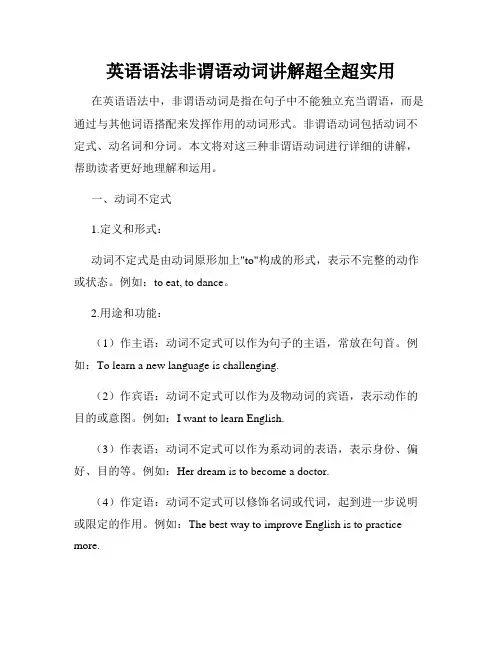
英语语法非谓语动词讲解超全超实用在英语语法中,非谓语动词是指在句子中不能独立充当谓语,而是通过与其他词语搭配来发挥作用的动词形式。
非谓语动词包括动词不定式、动名词和分词。
本文将对这三种非谓语动词进行详细的讲解,帮助读者更好地理解和运用。
一、动词不定式1.定义和形式:动词不定式是由动词原形加上"to"构成的形式,表示不完整的动作或状态。
例如:to eat, to dance。
2.用途和功能:(1)作主语:动词不定式可以作为句子的主语,常放在句首。
例如:To learn a new language is challenging.(2)作宾语:动词不定式可以作为及物动词的宾语,表示动作的目的或意图。
例如:I want to learn English.(3)作表语:动词不定式可以作为系动词的表语,表示身份、偏好、目的等。
例如:Her dream is to become a doctor.(4)作定语:动词不定式可以修饰名词或代词,起到进一步说明或限定的作用。
例如:The best way to improve English is to practice more.(5)作状语:动词不定式可以表示时间、目的、方式等状语的作用。
例如:I went to the park to relax.3.特殊用法:(1)省略to:在某些情况下,不定式的to可以省略,例如在助动词let、make、help等后面。
例如:Let me go.(2)动词不定式的时态:动词不定式没有人称和数的变化,但可以根据不同的时间来使用不同的时态。
例如:I want to go shopping.(现在时态)I wanted to go shopping.(过去时态)二、动名词1.定义和形式:动名词是由动词加上-ing构成的形式,可以作为名词使用。
例如:swimming, running。
2.用途和功能:(1)作主语:动名词可以作为句子的主语,常放在句首。

英语中不定式(todo)的6种成分和2种独立用法非谓语是英语学习的重点也是难点,很多同学对这个语法知识一直是处于比较懵的状态。
其实只要掌握非谓语所充当成分的用法就可以运用自如了。
非谓语,顾名思义就是不做谓语的动词的变化形式,即to do ,doing,done。
除了谓语,句子成分中还有主语、宾语、表语、宾语补足语、定语和状语。
下面看看不定式(to do)充当这6种成分的用法:一、不定式作主语1.To see is to believe. (这种情况不常用)2. It is important to learn English well.It 是形式主语,真正的主语是 to learn English well. 这种用法是常用的而且是考点!考点!考点!二、不定式作表语:常说明主语的内容、性质和特征或表动作将要发生。
1. My job is to keep the children safe.2.My task is to type the article.三、不定式做宾语1.He prefers to eat white bread and rice.2.He wants to play football.3.动词feel, find, make, think等后面,可以用it作形式宾语代替真正的宾语——动词不定式,句子结构是...feel / find / make / ... it+adj. / n.+to do...。
如:I find it difficult to remember everything.常接动词不定式作宾语的动词有:(需要记住)agree, afford, appear, ask, attempt;care, choose, claim;dare,decide,demand,deserve,determine;expect, fail, get, guarantee;hate, hesitate, hope, hurry;intend, learn, manage, offer,plan, prepare, pretend, promise;refuse, seem, tend, threaten;want, wish 等四、不定式做宾语补足语1.I'd invite her to have dinner at my house.2 . We should allow the children to choose their own clothes.Note 1: 带to的动词不定式作宾语补足语的动词主要有:要求允许提议(ask, allow, advise),期望邀请鼓励(expect, invite, encourage),教导告诉想要(teach, tell, want),等待希望愿意(wait for, wish, would like / love)。

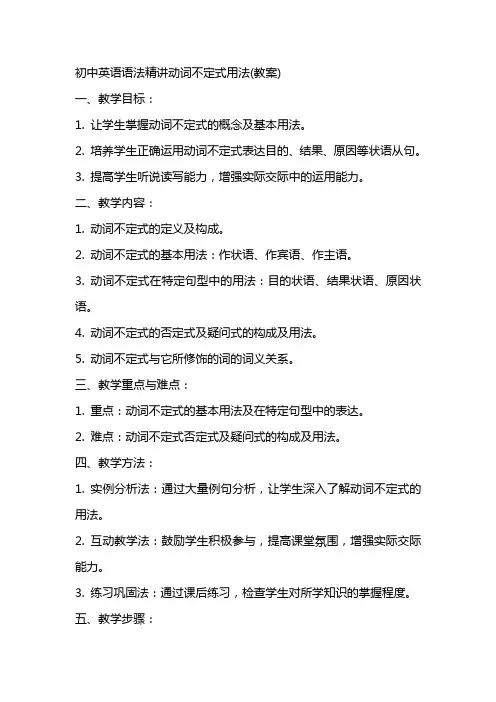
初中英语语法精讲动词不定式用法(教案)一、教学目标:1. 让学生掌握动词不定式的概念及基本用法。
2. 培养学生正确运用动词不定式表达目的、结果、原因等状语从句。
3. 提高学生听说读写能力,增强实际交际中的运用能力。
二、教学内容:1. 动词不定式的定义及构成。
2. 动词不定式的基本用法:作状语、作宾语、作主语。
3. 动词不定式在特定句型中的用法:目的状语、结果状语、原因状语。
4. 动词不定式的否定式及疑问式的构成及用法。
5. 动词不定式与它所修饰的词的词义关系。
三、教学重点与难点:1. 重点:动词不定式的基本用法及在特定句型中的表达。
2. 难点:动词不定式否定式及疑问式的构成及用法。
四、教学方法:1. 实例分析法:通过大量例句分析,让学生深入了解动词不定式的用法。
2. 互动教学法:鼓励学生积极参与,提高课堂氛围,增强实际交际能力。
3. 练习巩固法:通过课后练习,检查学生对所学知识的掌握程度。
五、教学步骤:1. 引入:以一段对话或故事引出动词不定式的概念,激发学生兴趣。
2. 讲解:讲解动词不定式的定义、构成及基本用法。
3. 示范:用多个例句展示动词不定式在句子中的不同作用。
4. 练习:让学生用动词不定式完成句子,体会其用法。
5. 拓展:讲解动词不定式在特定句型中的用法,如目的状语、结果状语、原因状语。
6. 互动:分组讨论,让学生用动词不定式造句,相互交流。
7. 总结:对本节课的主要内容进行总结,强调重点和难点。
8. 作业:布置课后练习,让学生巩固所学知识。
六、教学评估:1. 课堂参与度:观察学生在课堂上的积极参与程度,提问和回答问题的积极性。
2. 练习完成情况:检查学生课后练习的完成情况,评估他们对动词不定式用法的掌握程度。
3. 小组讨论:评估学生在小组讨论中的表现,包括合作态度和创造性运用动词不定式的能力。
七、课后作业:1. 抄写课堂上的例句,并用自己的话造句,运用动词不定式。
2. 编写一篇小短文,尽可能多地使用动词不定式。

初三英语语法点拨动词不定式的用法与实例初三英语语法点拨:动词不定式的用法与实例在初三英语的学习中,动词不定式是一个非常重要的语法点。
掌握动词不定式的用法对于我们正确理解和运用英语句子有着至关重要的作用。
接下来,让我们一起深入了解动词不定式的奇妙世界。
一、动词不定式的构成动词不定式的基本形式是“to +动词原形”,其中“to”是动词不定式的符号,没有实际意义。
例如:“to study”(学习)、“to play”(玩耍)。
需要注意的是,在某些情况下,“to”可以省略。
例如,在使役动词(let, make, have)和感官动词(see, hear, watch, feel, notice 等)后作宾语补足语时,要省略“to”。
例如:“Let him go”(让他走。
)“I saw her come in”(我看见她进来了。
)二、动词不定式的用法1、作主语动词不定式作主语时,通常位于句首。
但为了保持句子平衡,常用“it”作形式主语,将真正的主语——动词不定式后置。
例如:“To learn English well i s not easy”(学好英语不容易。
)这句话可以改写为:“Itis not easy to learn English well”2、作宾语一些动词后常接动词不定式作宾语,如:want, hope, wish, decide, plan, expect 等。
例如:“I want to go home”(我想回家。
)“She decides to study harder”(她决定更努力学习。
)3、作宾语补足语某些动词(如:ask, tell, want, teach, allow 等)后可接带“to”的动词不定式作宾语补足语。
例如:“The teacher asked us to do our homework carefully”(老师要求我们认真做作业。
)4、作定语动词不定式作定语时,要放在被修饰的名词或代词之后。
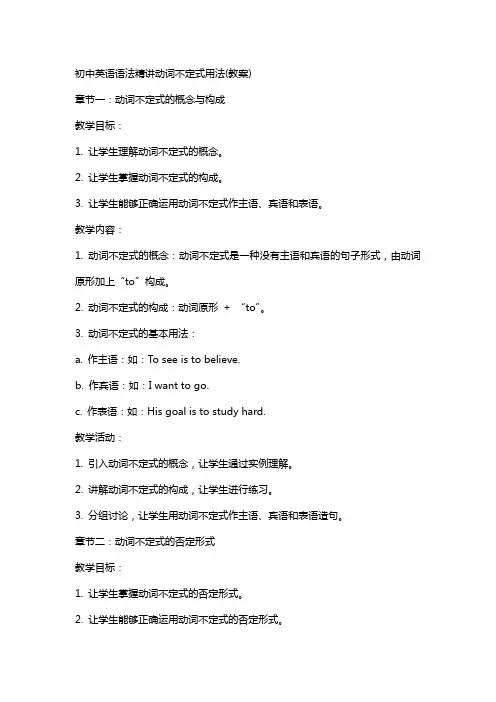
初中英语语法精讲动词不定式用法(教案)章节一:动词不定式的概念与构成教学目标:1. 让学生理解动词不定式的概念。
2. 让学生掌握动词不定式的构成。
3. 让学生能够正确运用动词不定式作主语、宾语和表语。
教学内容:1. 动词不定式的概念:动词不定式是一种没有主语和宾语的句子形式,由动词原形加上“to”构成。
2. 动词不定式的构成:动词原形+ “to”。
3. 动词不定式的基本用法:a. 作主语:如:To see is to believe.b. 作宾语:如:I want to go.c. 作表语:如:His goal is to study hard.教学活动:1. 引入动词不定式的概念,让学生通过实例理解。
2. 讲解动词不定式的构成,让学生进行练习。
3. 分组讨论,让学生用动词不定式作主语、宾语和表语造句。
章节二:动词不定式的否定形式教学目标:1. 让学生掌握动词不定式的否定形式。
2. 让学生能够正确运用动词不定式的否定形式。
1. 动词不定式的否定形式:在“to”前面加上“not”,即“not to”。
2. 动词不定式的否定形式的用法:表示否定意义,如:I don't want to go.教学活动:1. 讲解动词不定式的否定形式,让学生进行练习。
2. 小组活动,让学生用动词不定式的否定形式造句。
章节三:动词不定式的疑问形式教学目标:1. 让学生掌握动词不定式的疑问形式。
2. 让学生能够正确运用动词不定式的疑问形式。
教学内容:1. 动词不定式的疑问形式:在“to”前面加上“do/does/did”,如:Do you want to go?2. 动词不定式的疑问形式的用法:用于提问,如:Do you want to go shopping?教学活动:1. 讲解动词不定式的疑问形式,让学生进行练习。
2. 小组活动,让学生用动词不定式的疑问形式提问。
章节四:动词不定式作主语教学目标:1. 让学生掌握动词不定式作主语的用法。

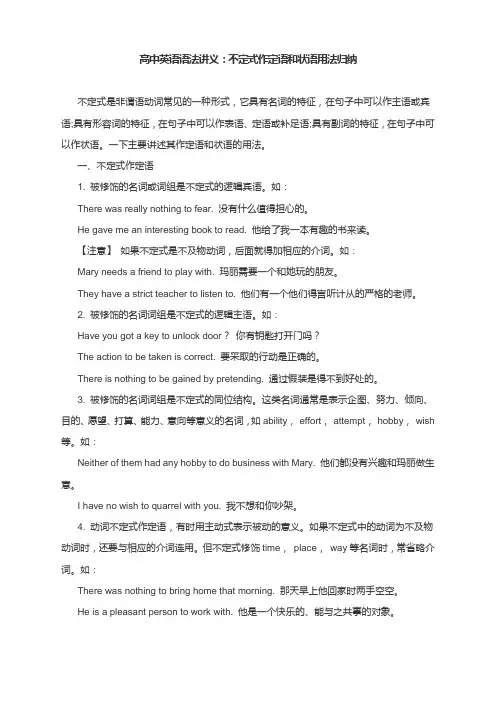
高中英语语法讲义:不定式作定语和状语用法归纳不定式是非谓语动词常见的一种形式,它具有名词的特征,在句子中可以作主语或宾语;具有形容词的特征,在句子中可以作表语、定语或补足语;具有副词的特征,在句子中可以作状语。
一下主要讲述其作定语和状语的用法。
一、不定式作定语1. 被修饰的名词或词组是不定式的逻辑宾语。
如:There was really nothing to fear. 没有什么值得担心的。
He gave me an interesting book to read. 他给了我一本有趣的书来读。
【注意】如果不定式是不及物动词,后面就得加相应的介词。
如:Mary needs a friend to play with. 玛丽需要一个和她玩的朋友。
They have a strict teacher to listen to. 他们有一个他们得言听计从的严格的老师。
2. 被修饰的名词词组是不定式的逻辑主语。
如:Have you got a key to unlock door?你有钥匙打开门吗?The action to be taken is correct. 要采取的行动是正确的。
There is nothing to be gained by pretending. 通过假装是得不到好处的。
3. 被修饰的名词词组是不定式的同位结构。
这类名词通常是表示企图、努力、倾向、目的、愿望、打算、能力、意向等意义的名词,如ability,effort,attempt,hobby,wish 等。
如:Neither of them had any hobby to do business with Mary. 他们都没有兴趣和玛丽做生意。
I have no wish to quarrel with you. 我不想和你吵架。
4. 动词不定式作定语,有时用主动式表示被动的意义。
如果不定式中的动词为不及物动词时,还要与相应的介词连用。
高中英语语法:不定式的用法_动词不定式具有名词、形容词和副词的特征。
因此在句中可以做主语、表语、宾语、宾语补足语、定语和状语。
一、不定式做主语:1、不定式做主语一般表示具体的某次动作。
===动名词doing 表示习惯的,经常的动作。
e.g: To finish the building in a month is difficult.To do such things is foolish.To see is to believe. (对等)注: 1). 不定式作主语时,谓语用单数2). 当主语较长,谓语较短时,常用it做形式主语,而将不定式放到谓语的后面。
it做形式主语,不定式放在谓语动词之后常用于下列结构中:(1)It is/was +adj.+of sb. to do(2) It is +adj.+for sb.+to doIt is easy / difficult / hard / foolish / unwise / right / wrong / unnecessary(3) it is +a +名词+ to do...It is a pity / a pleasure / a pleasant thing / one s duty / an honor / a shame / a crime / no easy job to doIt takes (sb.) some time / courage / patience to doIt requires courage / patience / hard work to do *注意: probable 和 possible 均可作表语,但possible可以用不定式作真实主语,而probable不能用不定式作真实主语。
It is probable for him to come to the meeting.(错) It is possible for him to come to the meeting.It is possible / probable that he will come to the meeting.二、不定式做表语主语是以aim duty hope idea intention plan job suggestion wish purpose task 等为中心词的名词词组或以what 引导的名词性从句表示,后面的不定式说明其内容, 不定式作表语常表示将来或现在的动作或状态。
不定式既具有动词的一些特征,又具有名词,形容词和副词的句法功能否定式:not +不定式不定式的时态一般说来,不定式一般式表示的动作有时与限定动词表示的动作同时发生,也有时发生在限定动词表示的动作之后。
如:Who heard him say that?He seems to know this.I hope to see you again.不定式进行式表示动作正在进行,通常与限定动词表示的动作同时发生,如:They are said to be building another bridge across the river.I happened to be going that way too.不定式完成式表示的动作发生在限定动词表示的动作之前,如:I am sorry to have given you so much trouble.I am glad to have seen your mother.不定式的句法功能(1)作主语To talk with him is a great pleasure.不定式短语作主语时,为了保持句子的平衡,往往以it作形式主语,而把不定式短语置于谓语动词之后,如:It’s nice to hear your voice.(2)作表语Her wish is to become an artist.(3)作宾语常用于及物动词: want , hope, wish, like, need, hate, offer, prefer, begin, start, attempt, decide, determine, expect, promise, pretend, refuse ,afford, ma nage, help等之后,如:You should continue to learn as long as you live.注1:如果作宾语的不定式又有自己的补语,则须用先行词it 作形式宾语,而将真正的宾语不定式后置,如:They found it impossible to get everything ready in time.注2:不定式一般不能作介词的宾语,只有在极少数介词如:but, except等后边才行。
动词不定式的语法总结动词不定式是非谓语动词的一种形式,是英语中常见的一种语法,学生一定要做好总结,拿下这个知识点。
小编为大家力荐了动词不定式常用的语法总结,给大家作为参考,欢迎阅读!动词不定式的七种用法动词不定式的基本形式为to+动词原形.1.动词不定式做主语.谓语用第三人称单数形式.如果主语较长则用it做形式主语,将真正的主语动词不定式放到句尾.egTo see is to believe.It's a bad habit to run after dinner.2 做表语.the important things is to save lives.3 做宾语he likes to play with children.4做宾语补足语.形容词做宾补时.常用it做形式宾语.把真正的宾语放到宾补之后.he feels it happy to help others.5做定语she asked me to help her with her English.6做状语you are never too old to learn.(结果状语)7特殊疑问词+动词不定式.I am thinking about what to say.动词的不定式的用法口诀①不定式有标记,to与动词连一起。
②没有人称数变化,动词特点它具备。
③主宾定状表补语,唯独作谓不可以。
④not 加上不定式,否定结构要牢记。
⑤疑问词与不定式,构成短语有意义。
⑥仔细推敲多思考,准确判断有依据。
动词不定式专题练习1. This company was the first ____ portable radios as well as cassette tape recorders in the world.A. producingB. to produceC. having producedD. produced2. The purpose of new technology is to make life easier, ____it more difficult.A .not making B. not make C .not to make D. nor to make3. Helen had to shout ______above the sound of the music .A .making herself hear B. to make herself hearC. making herself heard D .to make herself heard4. I don’t know whether you happen_______ ,but I am going to study in the U.S.A this September.A .to be heard. B. to be bearing C .to hear D .to have heard5. The news reporters hurried to the airport, only ______the film stars had left.A .to tellB .to be toldC .tellingD .told6. You were silly not _______your car.A. to lockB. to have lockedC. lockingD. having locked7. The teacher asked us ______so much noise.A .don’t make B. not make C. not making D .not to make8. An army spokesman stressed that all the soldiers had been ordered _____clear warnings before firing any shots.A .to issue B. being issued C. to have issued D. to be issued9. I’d rather have a room of my own, however small it is, than_______ a room with someone else.A. to shareB. to have sharedC. shareD. sharing10. The bank is reported in the local newspaper_________ in broad daylight yesterday.A. robbedB. to have been robbedC. being robbedD. having been robbed11. A number of paintings in the castle are believed ________ina fire.A. being destroyedB. having been destroyedC. to be destroyedD. to have been destroyed12. The meeting _______ next week is sure to be a great success.A. to take placeB. to be taken placeC. to have taken placeD. being taken place13. As a result of my laziness, I failed ________ my work in time.A. and finishedB. to finishC. and finishingD. to finished14. I am sorry ______ written you a letter at the time.A. to have notB. to not haveC. not to haveD. not having15. Will you lend him a magazine _________?A. to be readB. for readingC. to readD. he read16. He could do nothing but _______for the bus _________.A. wait, to comeB. wait; comeC. waiting; comingD. waited; came17 .It is a problem that doesn't need ________ right now.A. to solveB. solvingC. being solvedD. to be solving18. There’s a man at the reception desk who seems very angry and I think he means _______ trouble.A. makingB. to makeC. to have madeD. having made19. I remember _______him _______the bike needed __________.A. hearing, saying, to repairB. to hear, say, to repairC. hearing, say, repairingD. to hear, saying, to be repaired20. --- You should have thanked her before you left.--- I meant _________, but when I was leaving I couldn’t find her anywhere.。
高中英语动词不定式语法总结一、动词不定式的定义和特点动词不定式是英语语法中的一种重要形式,用于表示一个将要发生或尚未发生的动作。
它具有名词、形容词和副词的特征,可以作为句子中的独立成分,与句子中的其他成分保持语法和语义的连贯性。
二、动词不定式的时态和语态1. 时态:动词不定式可以有不同的时态形式,包括一般式、进行式和完成式。
例如,不定式的一般式表示一个一般性的动作;不定式的完成式表示一个已完成的动作,发生在句子谓语动词之前。
2. 语态:动词不定式可以有被动语态形式,表示一个动作由他人或某物所导致。
三、动词不定式的复合结构动词不定式可以有自己的复合结构,即“名词所有格”或“动词-ing”形式加上“to do”。
这些结构可以作主语、宾语、表语等,与句子的主语形成语法上的关系。
四、动词不定式的句法功能动词不定式可以在句中充当各种句法成分,如主语、宾语、表语、定语等。
同时,它可以与一些词类连用,如形容词、副词、介词短语等。
五、常用动词不定式短语和结构1. it + 形容词/ 名词 + 不定式结构:表示将来的计划或情况。
2. be + 形容词 + to do:表示某人愿意或想要做某事。
3.感官动词 + 不定式结构:表示一种观察或感受。
4. 疑问词 + 不定式结构:可以用于询问目的或意图。
5. 介词 + 名词/ 动名词 + to do:表示一种方式或手段。
六、动词不定式的否定形式动词不定式的否定形式是在不定式符号前加上“not”。
同时,有一些特殊的否定结构,如“hardly/ scarcely + 否定词+ to do”、“not so much to do as to do”等。
七、动词不定式的疑问形式动词不定式的疑问形式是将疑问词直接放在不定式符号前,构成一个疑问句。
常见的疑问词有who/ what/ which/ how/ when/ where等。
八、动词不定式的省略形式在某些情况下,动词不定式可以省略,特别是在一些固定短语中。
高中英语语法讲解不定式(The Infinitive)定义:动词不定式是非谓语动词的一种,它没有人称和数的变化,在句子中不能独立作谓语,但它仍保持动词的特点,既可以有自己的宾语和状语。
E.g.He want his students to read the book aloud.A.1不定式的构成(以动词do为例)主动形式被动形式一般式to do to be done完成式to have done to have been done进行式to be doing 无完成进行式to have been doing 无2 不定式的意义不定式的一般式(to do)一般式表示的动作或状态,发生在谓语动词表示的动作或状态的同时或之后My wish is to become a doctorHe seemed to be tired.She stopped to have a rest.不定式的被动式(to be done)当不定式的逻辑主语是这个不定式所表示的动作的承受者时,不定式一般要用被动式.The building to be finished next month is for our teachers.I am going to Beijing,I have something to take to my parents,do you have something to be taken to your parents?如果谓语表示的动作(情况)发生时,不定式表示动作正在进行,这时候不定式就要用进行式.(to be doing)They are said to be building another bridge across the street.They seemed to be talking about something important.When I went to his home,he happened to be traveling around the world.I’m glad to be working with you.如果不定式所表示的动作或状态发生在谓语动词所表示动作或状态之前,就用完成式(to have done);若是在此基础上的被动含义,就用完成被动式(to have been done).He is said to have written a novel about the Long March.He thought it a pity not to have invited us.The assistant seemed to have been fired.He is said to have been taught French when he was a child.Einstein is said to have built up his theory when he was in his twenties.如果不定式的动作是在谓语所表示的时间之前一直在进行的动作,就要用完成进行式.They are said to have been collecting folk song in Xinjiang.We’re happy to have been working with the experts all the month.B.用法:动词不定式具有名词、形容词和副词的特征。
因此在句中可以做主语、表语、宾语、宾语补足语、定语和状语。
一、不定式做主语:1、不定式做主语一般表示具体的某次动作。
===动名词doing表示习惯的,经常的动作。
e.g:To finish the building in a month is difficult.To do such things is foolish.To see is to believe.(对等)注:1).不定式作主语时,谓语用单数2).当主语较长,谓语较短时,常用it做形式主语,而将不定式放到谓语的后面。
it做形式主语,不定式放在谓语动词之后常用于下列结构中:(1)It is/was+adj.+of sb.to do…(2)It is+adj.+for sb.+to do…It is easy/difficult/hard/foolish/unwise/right/wrong/unnecessary(3)it is+a+名词+to do...It is a pity/a pleasure/a pleasant thing/one’s duty/an honor/a shame/a crime/no easy job…to doIt takes(sb.)some time/courage/patien ce…to do…It requires courage/patience/hard work…to do…*注意:probable和possible均可作表语,但possible可以用不定式作真实主语,而probable 不能用不定式作真实主语。
It is probable for him to come to the meeting.(错)It is possible for him to come to the meeting.It is possible/probable that he will come to the meeting.二、不定式做表语主语是以aim duty hope idea intention plan job suggestion wish purpose task等为中心词的名词词组或以what引导的名词性从句表示,后面的不定式说明其内容,不定式作表语常表示将来或现在的动作或状态。
eg My idea is to climb the mountain from the north.Your mistake was not to write that letter.What I would suggest is to start work at once.三动词不定式作宾语以不定式结构为宾语的动词有:ask,agree,care,choose,demand,decide,expect,fail,help,hope,learn,manage,offer,plan, prepare,pretend,promise,refuse,want,wish等只能用动词不定式作宾语口诀(接不定式作宾语的动词)想要学习早打算(want learn plan)快准备有希望(prepare hope wish expect)同意否供选择(agree offer choose)决定了已答应(decide be determined promise)尽力去着手做(manage undertake)别拒绝别假装(refuse pretend)失败不是属于你(fail)e.g.Tom refused to lend me his pen.We hope to get there before dark.The girl decided to do it herself.*注意:某些及物动词可用-ing也可用动词不定式作宾语但意义不同的有stop go on remember forgetregret try mean can’t helpbe used to四.动词不定式做定语1..不定式作定语需要后置。
2.作定语的不定式与被修饰的名词或代词存在着两种主要的逻辑关系,即被修饰的名词和代词是不定式的逻辑主语(逻辑上的主谓关系)或逻辑宾语(逻辑上的动宾关系)1)不定式前的名词是它的逻辑主语。
He is the doctor to do the operation.2)不定式和它所修饰的名词是逻辑上的动宾关系。
I have a lot of things to do.3)不定式前的名词是它修饰的对象。
This is the right time to start.注意.如果不定式所修饰的词是way或place,介词可省略。
He has no way to go(by).This is the best place to work(at)五.宾语补足语He want you to be his assistant.I saw her cross the street.[注1]如果谓语动词为感官动词或使役动词,则作宾补的不定式不可带to,这些动词有see,hear,feel,watch,notice;have,make,let等。
I felt my blood run cold.What made you think like that?但如果句子是被动语态,则to不可省略。
He was made to clean the windows as a punishment.Someone was heard to come up the stairs.[注2]1.谓语动词help后可接带to或不带to的不定式作宾补。
用不带to的不定式表示帮助者直接参与动作;用带to的不定式表示主语没有直接参与动作。
They helped me carry the boxes.This kind of soap will help you to wash the clothes more easily.2.在美式英语或非正式文体中,help后用作宾补的不定式均不带to。
3.help后可以直接用带to或不带to的不定式作宾语。
They helped(to)carry the furniture upstairs.[注3]look at及listen to后用作宾补的不定式不带to(这主要是美式英语)。
We have been listening to the radio tell a long story.六.表语补足语当不定式与主语存在逻辑上动宾关系的时候,用主动表被动。
That is hard to say.The chair is comfortable to sit in.七.不定式做状语不定式做状语修饰动词、形容词、副词等,表示目的、原因、结果、条件等。
1、表目的e.g.To learn a foreign language well,you must try your best(主语一致)He came here to attend an important meeting.He came here in order to see Charlie.I turned the radio down so as not to disturb him注:表示目的的不定式可以置于句首,这也是区别于其他功能的标志之一。